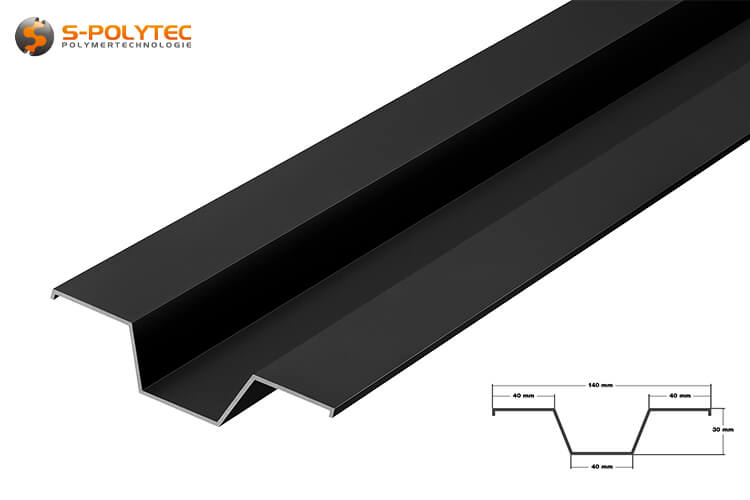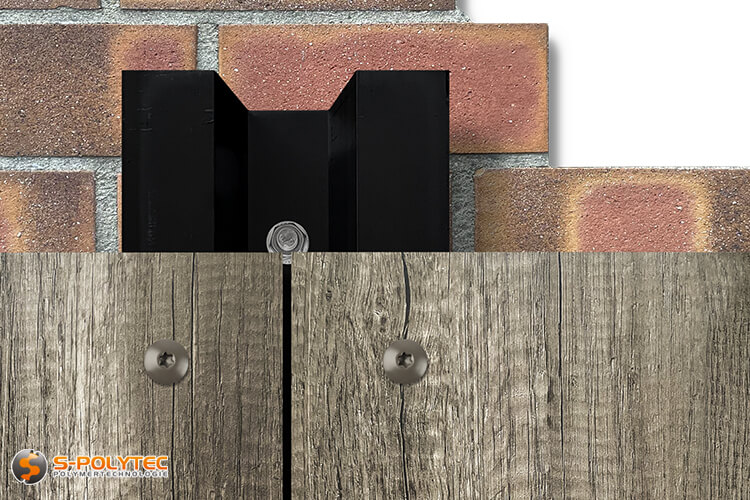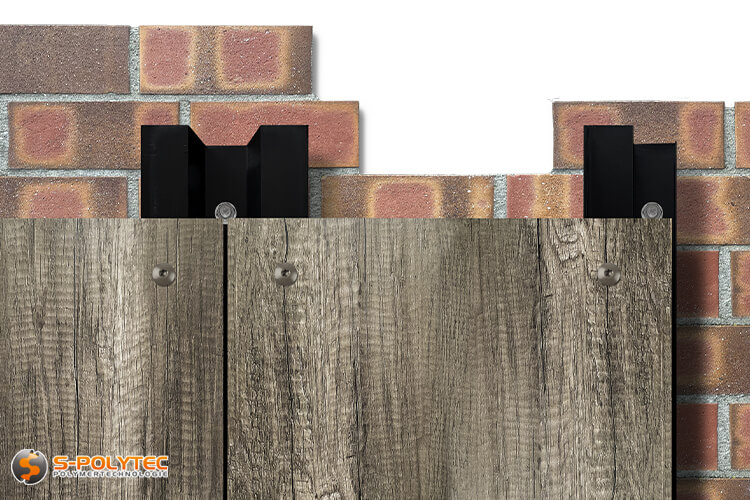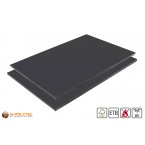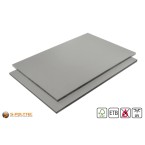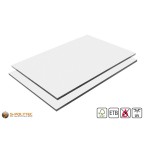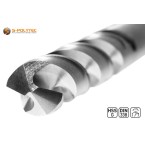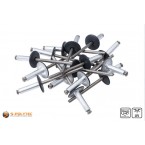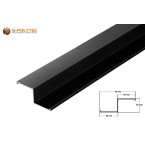
Aluminium V-Profiles Black (Anodised)
Our V-profiles made of black anodised aluminium are used for substructures where two facade panels are to be mounted next to each other. Thanks to the anodised surfaces, the aluminium profiles are characterised by outstanding corrosion resistance.
✓ Black anodised aluminium
✓ Corrosion resistant
✓ Enormously torsionally stiff
✓ High load capacity
✓ Maintenance-free
The aluminium connecting profiles are available in 2000mm lengths at favourable graduated prices.
The item is in stock
Dispatch within 2 - 3 working days
- calculate the price
- at pieces 0,00 € (Base Price 0,00 € / m)
- at pieces 0,00 € (Base Price 0,00 € / m)
- at pieces 0,00 € (Base Price 0,00 € / m)
All prices include 19% VAT.
0,00 € / pc.
0,0000kg / pc.
All prices include 19% VAT.
- Description
V-profiles made of black anodised aluminium for facade cladding
Corrosion-resistant ✓ AW EN 6063 T6 aluminium ✓ Maintenance-free ✓
Our black anodised V-profiles are available in the standard length of 2000mm at favourable graduated prices and are made of corrosion-resistant AW EN 6063 T6 aluminium. The width of the Z-profile is 140mm, whereby both support surfaces for fastening the facade panels and the support surface for wall mounting each have a width of 40mm. As with our Z profiles, the profile depth is 30mm, resulting in a minimum distance to the wall of 30mm. The thickness of the solid aluminium profiles is 2mm. This results in a very high torsional rigidity and also contributes to the very high load-bearing capacity. This means that it is also possible to mount facade panels with a high weight or in higher panel thicknesses, for example HPL panels or fibre cement panels.
V-profiles are used when large-area facade cladding is to be erected, the width of which cannot be covered by a single panel. Due to the mounting surface on both sides, two adjoining cladding panels can be fixed with one profile rail of the substructure, whereby the ideal distance between the individual panels for thermal expansion is guaranteed. This saves time when mounting the substructure, because only one hat profile instead of two Z profiles has to be attached to the wall, and money, because one V profile is cheaper than two Z profiles of identical length.
NOTE: Because the number of fixings varies depending on the load-bearing capacity of the facade as well as the required number of panel fixings, our aluminium profiles for substructures are not pre-drilled. However, holes can be drilled without any problems using a standard cordless screwdriver and a conventional HSS drill.
TIP: For shortening the anodised aluminium hat profile in black, we recommend a cross-cut saw with metal saw blade.
Properties of the aluminium hat profile black (anodised) for substructures
Our V-profiles are made of solid aluminium, which is then anodised black (also called anodised). Through the so-called anodising process, an oxidic protective layer is created on the surfaces through anodic oxidation. This oxide layer ensures that the surfaces of the aluminium profiles receive the best possible protection against corrosion caused by environmental influences, which has a positive effect on the longevity of the substructure. Rotting due to moisture and the effects of the weather are not to be sneezed at with wooden constructions. This can contribute to higher costs for building maintenance and renovation measures. Especially in the case of facade cladding, which is almost completely covered by the facade panels, refreshing the weather protection of the timber substructure can only be carried out at considerable expense. Facade substructures made of anodised aluminium, on the other hand, are considered maintenance-free.
V-profiles are often also called hat profiles. The reason for this is the view of the cross-section, which is reminiscent of a hat with a circumferential brim. The mounting surfaces for fastening the adjoining facade panels are 40mm each. The mounting surface for screwing to the facade also has a wide area of 40mm, which ensures sufficient contact surface for a perfect hold and also offers sufficient clearance for the holes of the fixings. The total width of the V-profile is 140mm. This allows facade panels to be fixed to a profile with sufficient spacing between each other, taking into account the required hole spacing from the edge of the panel. As with our Z profiles, the profile depth of the hat profiles is also 30mm, for a sufficient wall distance that can be used for rear ventilation or additional thermal insulation. In addition, the profiles with the threaded anchors can also be mounted at a constant distance from the masonry (or concrete) in order to use insulation with a higher thickness and better insulation values. The profile thickness of 2 mm ensures sufficient stability, even if facade panels with a high dead weight are to be fixed to the substructure, as is the case with HPL panels or facade panels made of fibre cement.
Approvals & Standards of the anodised V-profile
- Made of aluminium according to DIN EN 755-2 and DIN EN 573-3
Application and assembly of the V-profiles made of black anodised aluminium
Substructures of facade claddings with Z-profiles and V-profiles are usually attached to the facade in a vertical direction and aligned so that the facade panels can be mounted evenly by screwing or riveting. While Z-profiles form the outer profile rails of the substructure, V-profiles are attached at the positions where two facade panels are to be fixed next to each other. The V-profile is mounted centrally between the two panels on the wall to be clad. The two contact surfaces are aligned by the angle of the profile in such a way that a sufficient edge distance of the panel holes is ensured. This prevents the holes from breaking out towards the edge of the panel and contributes to a homogeneous, pleasing appearance, as the holes in the facade panels can be made with the same edge distance for Z-profiles and V-profiles.
For end profiles of facade substructures, the V-profiles are only suitable to a limited extent thanks to the mounting surface on both sides, so that we recommend our Z-profiles in 2 metre lengths instead. These are also suitable as intermediate profiles for larger panel formats.
Application examples for aluminium facade profiles
- Alu V-profiles are maintenance-free and therefore perfectly suitable for long-lasting substructures
- Aluminium profiles are excellent for riveting with our aluminium facade rivets
- Ventilated facade cladding is very easy to implement with a profile depth of 30mm
- V-profiles are used as connecting profiles of adjoining facade panels
- The connecting profiles ensure an ideal distance between two facade panels
Please note that different dowels and threaded anchors must be used depending on the material of the facades to be clad. In addition, the number of fixings must be adapted to the load-bearing capacity of the masonry and, in the case of installation at an increased distance from the wall, diagonal fixings may also be required to counteract vertical distortion. For wall mounting, we recommend threaded bolts or impact anchors with a diameter of at least 8mm. For this, the profiles must be pre-drilled to the appropriate thickness. In our online shop, we also have ground HSS drills in various diameters that are perfectly suited for drilling the aluminium profiles.
The facade panels can be mounted either by gluing with a suitable mounting adhesive, by screwing with facade drilling screws, or by riveting with our aluminium facade rivets. Please always refer to the installation instructions of the panel manufacturer to find out whether bonding is suitable for the desired facade panel. For riveted joints with our facade rivets, the substructure profiles must be drilled with a 5.1 mm drill. For this, the hole drillings of the facade panels should be transferred to the substructure in advance to ensure that the positions of the drill holes of the panel and the profiles match. For these drill holes, too, we offer you the matching drills in ground HSS quality in our online shop.
Technical data of the V-profile made of black anodised aluminium
- Material: Aluminium AW 6063 T6
- Alloy: AlMgSi 0,7
- Surface: Anodised
- Colour: Black
- Profile thickness: 2mm
- Profile depth: 30mm
- Total width: 140mm
- Mounting surface wall: 40mm
- Mounting surface plate: 2x40mm
- UV resistance: Excellent
- Weather resistance: Excellent
- Corrosion resistance: Excellent
- Additional Information
Additional Information
Product-ID UK-002 Standart Length 2000 Delivery Time Dispatch within 2 - 3 working days EAN/GTIN 4260604226398 Material Aluminium anodised Profile type V-Profile Weight 0.9990 Color Black Color accuracy No Color designation Black - Reviews
